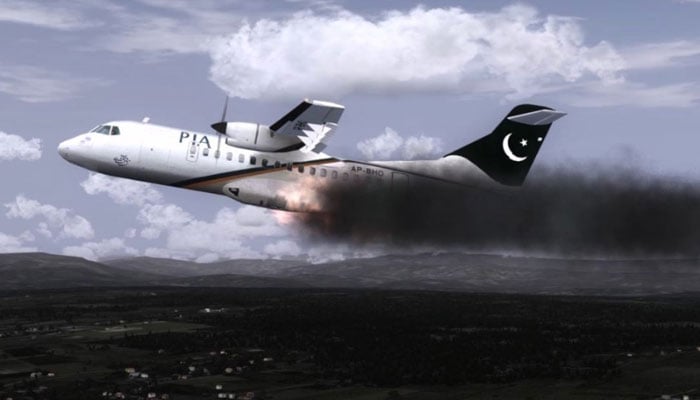Since 1956, numerous air tragedies have left hundreds dead in Pakistan
LAHORE: During the last 64 years and about three months, or since February 25, 1956, numerous Pakistani passenger planes have met painful aviation tragedies that left hundreds dead.
Pakistan, like any other country in the world, has a troubled history of air accidents that saw humans meeting painful deaths.
While some of the roasted bodies were found and identified in debris, ashes and ambers, many were not even identifiable for obvious reasons.
The latest disaster that left the nation mourning took place on Friday evening, just a couple of days before Eid, when a state-run Pakistan International Airlines (PIA) A320 passenger jet, flying from Lahore, crashed in a densely populated residential locality of Karachi, killing around 100 people on board.
However, a few extremely lucky ones - including the incumbent Bank of Punjab Chairman, Zafar Masood - miraculously emerged as one of the survivors, which is a rarity. Apart from the Pakistan International Airlines, a good number of private carriers in the country have also been involved in such fatal disasters.
The earliest aviation accident in Pakistan:
At 2:56 pm on February 25, 1956, a Gilgit-Rawalpindi freight plane has crashed near the village of Jalkot in Lastgarush Galli due to rain, sleet and thunderstorm, killing all three people onboard.
The wreckage of this aircraft was found on March 11, 1956. The probable cause officially listed was pilot error, while he was attempting a flight beyond his ability or experience.
Here follows the timeline and chronology of some other major air tragedies in Pakistan during the last six-and-a-half decades:
On July 1, 1957, some 24 people had lost lives after a Chittagong to Dhaka flight had crashed into the tides of the Bay of Bengal. The wreckage was found on July 4, 1957, on the coast of Charlakhi Island, which is about 50 miles west of Chittagong.
Probable cause: “The aircraft crashed after penetrating a thunderstorm and breaking up due to excessive forces placed upon the airframe.”
On May 15, 1958, a PIA aircraft had descended and struck ground after takeoff at night from Delhi Airport. The aircraft, flying for Karachi, had crashed an airport boundary fence, killing 21 of the 38 people on board.
Probable cause: “The captain did not properly observe and interpret his flight instruments and thus inadvertently permitted the aircraft to descend to the ground immediately after a night take off during which no visual reference was possible. A contributory factor may have been the slow reactions of captain due to his state of health.”
On March 26, 1965, another PIA Peshawar-Chitral flight had crashed at Lowari Pass near Dir valley, killing 22 of the 26 people on board.
On May 20, 1965, a Pakistan International Airlines Boeing 707 had crashed on its inaugural flight while attempting to land at Cairo airport, killing 119 people.
Probable cause: “The aircraft did not maintain adequate height for the circuit and continued to descend until it contacted the ground. The reason for that abnormal continuation of descent is unknown.”
On February 2, 1966, a PIA helicopter had crashed near Faridpur after striking a vulture in cruise flight, killing 23 of the 24 humans onboard.
On August 6, 1970, a Rawalpindi to Lahore flight had nosedived Rawat, killing 30 people on board.
On December 8, 1972, flying from Gilgit to Rawalpindi, a PIA Fokker F27, had nose-dived into a snow-capped mountain village called Maidan near Jalkot, killing at least 31 people.
On November 26, 1979, a PIA Boeing 707 bringing home Pakistani Hajj pilgrims from Saudi Arabia had crashed shortly after take-off from Jeddah airport, killing 156 people.
On October 23, 1986, a PIA Fokker F27 had met an accident, while it was coming in to land in Peshawar, killing 13 of the 54 people on board.
On August 17, 1988, a US-made Hercules C-130 military aircraft had crashed near Bahawalpur, after it had caught fire, killing the then military ruler Gen Ziaul Haq and 30 others including Pakistani generals and the US ambassador.
On August 25, 1989, a PIA Fokker carrying 54 people had disappeared after leaving Gilgit in northern Pakistan. The wreckage has never been found. This was one of the most terrible plane accidents of Pakistan’s Aviation history.
On September 28, 1992, a PIA Airbus A300 had hit a cloud-covered hillside on approach to the Nepalese capital, Kathmandu, after the plane had reportedly descended too early, killing 167 people.
On February 19, 2003, an Air Force Fokker F27 had crashed in the fog-shrouded mountains near Kohat, killing Pakistan Air Force Chief Mushaf Ali Meer, his wife and 15 others.
On February 24, 2003, a chartered Cessna 402-B carrying Afghan Mines and Industries Minister Juma Mohammad Mohammadi, four Afghan officials, a Chinese mining executive and two Pakistani crew members had plunged into the Arabian Sea near Karachi.
On May 8, 2015, a Pakistani military helicopter had crashed at Naltar Valley near Gilgit, killing eight people including the Norwegian, Philippine and Indonesian envoys stationed in Pakistan and the wives of Malaysian and Indonesian ambassadors.
Government officials and international dignitaries were travelling to the Naltar Valley where the-then Pakistani Prime Minister, Nawaz Sharif, was hosting lunch for the members of the diplomatic corps.
Premier Nawaz Sharif was scheduled to travel by fixed-wing aircraft, while 32 foreign diplomats and their spouses - as well as 25 other Pakistanis - were flown in from Islamabad to Gilgit Airport hours earlier, from where a flight of four helicopters was scheduled to transport them to nearby Naltar Valley.
On July 10, 2006, a Multan to Lahore Fokker flight could not reach its destination as it had crashed into a wheat field after burning into flames just about 10 minutes after the takeoff. Resultantly, all the 41 passengers and crew members were killed. Amongst the ill-fated passengers were the Vice-Chancellor of Bahauddin Zakariya University, Prof Dr Naseer Khan, and an internationally known Pakistani neurosurgeon, Prof Iftikhar Ali Raja.
On July 28, 2010, an Airblue Airlines aircraft (flying from Karachi) had smashed into the Margalla Hills outside Islamabad while it was preparing to land. All 152 people onboard had lost lives.
On November 5, 2010, a twin-engine plane, operated by Pakistani charter JS Air, had crashed shortly after take-off in Karachi, killing all 21 people on board. The plane was carrying staff of an Italian company to the Bhit gas field in Jamshoro district, where they were going on an exploration mission.
On November 28, 2010, at least 12 people were killed when a Russian-made cargo plane operated by a Georgian airline Sunway had crashed seconds after taking off from Karachi.
On April 20, 2012, a Bhoja Airlines plane, flying from Karachi to Islamabad, had confronted a tragedy after it was trapped in bad weather near the Pakistani capital. Officials said over 125 people had resultantly perished. This was the second-deadliest aviation accident in Pakistan after the July 2010 crash that had killed all 152 onboard, and was the fourth deadliest accident involving the Boeing 737-200 series.
On June 24, 2014, a female passenger had received a fatal bullet injury after a PIA Flight PK-756 was fired at during landing approach to Peshawar Airport. Meanwhile, two male flight attendants had received non-fatal bullet injuries. However, the aircraft had landed safely at Peshawar Airport. It was soon repaired and returned to service.
On December 7, 2016, a Pakistan International Airlines flight PK-661, carrying 48 passengers and crew, had crashed on the way to Islamabad from Chitral at 4:42pm PST. The Civil Aviation Authority confirmed there are no survivors from the ill-fated flight.
The passenger list confirmed there were 31 men, 9 women and 2 infants on board the flight, including singer-cum-evangelist Junaid Jamshed and his family, as well as three foreigners.
The-then PIA Chairman Azam Saigol (late), while addressing a press conference, had confirmed that all onboard had perished in the crash.
Saigol said the ill-fated ATR-42 aircraft went through a detailed inspection in October. Saigol further added that the plane was fit to fly but that it was unclear what caused the crash.
On July 30, 2019, some 17 people, including five crew members and 12 civilians, had lost their lives after a Pakistan Army aviation aircraft on a routine training flight crashed near Mora Kalu Rawalpindi.
According to an Inter-Services Public Relations (ISPR) press release, 12 others were injured in the incident.
The crew members martyred in the incident, including two pilots, were: Lt Col Saqib (pilot), Lt Col Waseem (pilot), Naib Subedar Afzal, Havaldar Ibne Ameen and Havaldar Rehmat.
The ISPR said that rescue teams of the Pakistan Army and Rescue 1122 had reached the site of the incident and a fire had been extinguished. All injured were shifted from the Holy Family Hospital to the Combined Military Hospital, Rawalpindi.
-
 Hollywood Meets Bollywood: Will Smith Eyes Shah Rukh Khan Collaboration
Hollywood Meets Bollywood: Will Smith Eyes Shah Rukh Khan Collaboration -
 'Hamnet' Jessie Buckley Offers Sincere Thanks To One Crew Member For THIS At Golden Globes
'Hamnet' Jessie Buckley Offers Sincere Thanks To One Crew Member For THIS At Golden Globes -
 Prince William May Force King Charles To Reject Harry's Invite?
Prince William May Force King Charles To Reject Harry's Invite? -
 China’s ‘Are You Dead?’ App Goes Viral: Here’s Why
China’s ‘Are You Dead?’ App Goes Viral: Here’s Why -
 Apple Tops Global Smartphone Market In 2025, Says Report
Apple Tops Global Smartphone Market In 2025, Says Report -
 Prince Harry Spokesperson Finally Reacts To Meghan Markle's UK Return Plan Claims
Prince Harry Spokesperson Finally Reacts To Meghan Markle's UK Return Plan Claims -
 Kim Kardashian Shares Terrifying Birthday Mishap
Kim Kardashian Shares Terrifying Birthday Mishap -
 'Stranger Things' Finale Documentary Has One Big Mystery Involving David Harbour, Winona Ryder
'Stranger Things' Finale Documentary Has One Big Mystery Involving David Harbour, Winona Ryder -
 Leonardo DiCaprio Leaves Fans Asking ONE Question After Golden Globes Appearance
Leonardo DiCaprio Leaves Fans Asking ONE Question After Golden Globes Appearance -
 Utah Cop 'turns Into Frog' In AI Police Report
Utah Cop 'turns Into Frog' In AI Police Report -
 Leonardo DiCaprio's Reaction To Nikki Glaser's Jokes At Golden Globes Goes Viral
Leonardo DiCaprio's Reaction To Nikki Glaser's Jokes At Golden Globes Goes Viral -
 Ofcom Opens Investigation Into Elon Musk’s X Over Grok AI Deepfakes
Ofcom Opens Investigation Into Elon Musk’s X Over Grok AI Deepfakes -
 Sarah Ferguson's Snake Phobia Complicates Her Next Move: Insider
Sarah Ferguson's Snake Phobia Complicates Her Next Move: Insider -
 Golden Globes 2026: 'The Pitt' And 'The Studio' Win Top Honors
Golden Globes 2026: 'The Pitt' And 'The Studio' Win Top Honors -
 Golden Globe 2026: Expert Defends Amanda Seyfried's 'mean' Reaction
Golden Globe 2026: Expert Defends Amanda Seyfried's 'mean' Reaction -
 Why Taylor Swift Docuseries, Travis Kelce Podcast Not Nominated For A Golden Globe 2026
Why Taylor Swift Docuseries, Travis Kelce Podcast Not Nominated For A Golden Globe 2026




